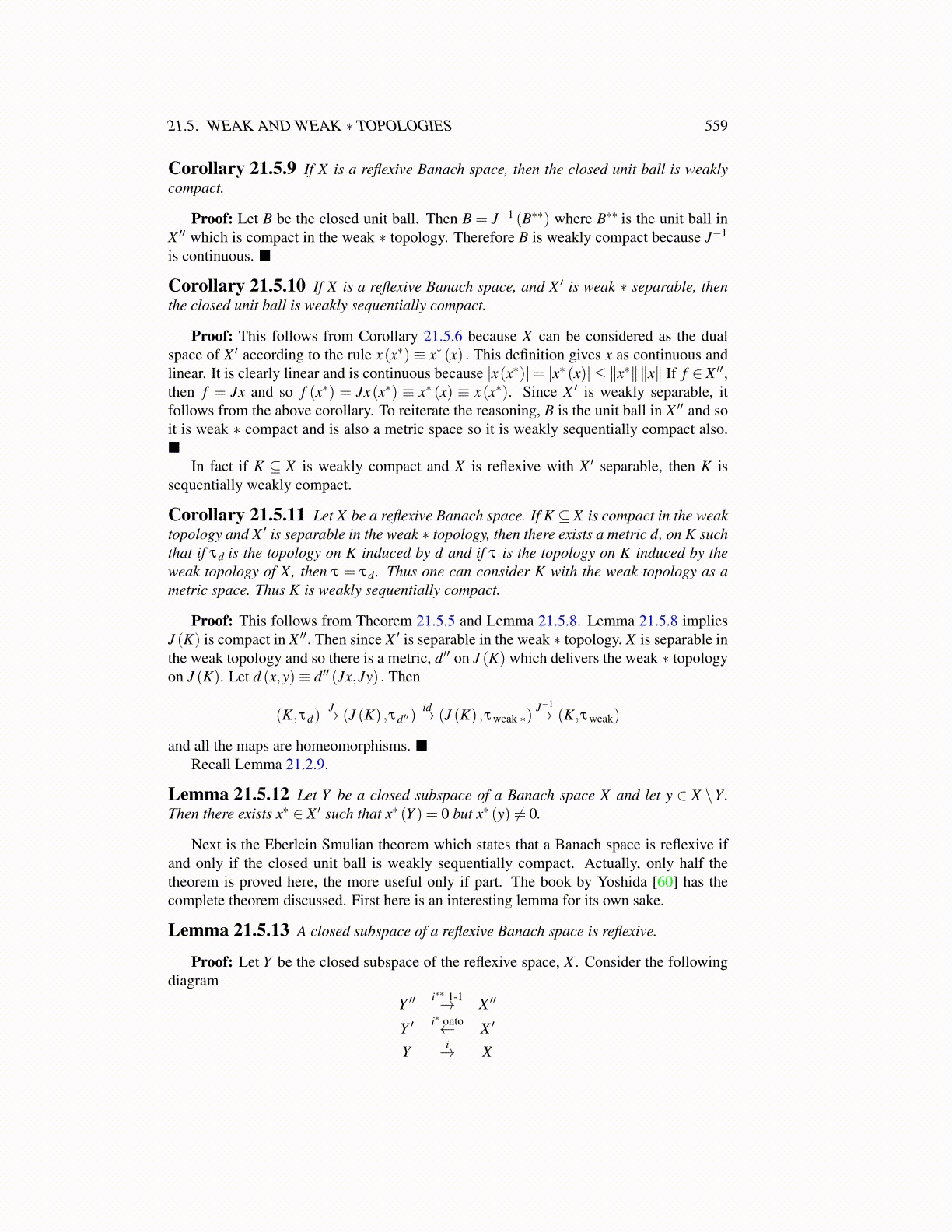
21.5. WEAK AND WEAK ∗ TOPOLOGIES 559
Corollary 21.5.9 If X is a reflexive Banach space, then the closed unit ball is weaklycompact.
Proof: Let B be the closed unit ball. Then B = J−1 (B∗∗) where B∗∗ is the unit ball inX ′′ which is compact in the weak ∗ topology. Therefore B is weakly compact because J−1
is continuous. ■
Corollary 21.5.10 If X is a reflexive Banach space, and X ′ is weak ∗ separable, thenthe closed unit ball is weakly sequentially compact.
Proof: This follows from Corollary 21.5.6 because X can be considered as the dualspace of X ′ according to the rule x(x∗)≡ x∗ (x) . This definition gives x as continuous andlinear. It is clearly linear and is continuous because |x(x∗)|= |x∗ (x)| ≤ ∥x∗∥∥x∥ If f ∈ X ′′,then f = Jx and so f (x∗) = Jx(x∗) ≡ x∗ (x) ≡ x(x∗). Since X ′ is weakly separable, itfollows from the above corollary. To reiterate the reasoning, B is the unit ball in X ′′ and soit is weak ∗ compact and is also a metric space so it is weakly sequentially compact also.■
In fact if K ⊆ X is weakly compact and X is reflexive with X ′ separable, then K issequentially weakly compact.
Corollary 21.5.11 Let X be a reflexive Banach space. If K ⊆ X is compact in the weaktopology and X ′ is separable in the weak ∗ topology, then there exists a metric d, on K suchthat if τd is the topology on K induced by d and if τ is the topology on K induced by theweak topology of X, then τ = τd . Thus one can consider K with the weak topology as ametric space. Thus K is weakly sequentially compact.
Proof: This follows from Theorem 21.5.5 and Lemma 21.5.8. Lemma 21.5.8 impliesJ (K) is compact in X ′′. Then since X ′ is separable in the weak ∗ topology, X is separable inthe weak topology and so there is a metric, d′′ on J (K) which delivers the weak ∗ topologyon J (K). Let d (x,y)≡ d′′ (Jx,Jy) . Then
(K,τd)J→ (J (K) ,τd′′)
id→ (J (K) ,τweak ∗)J−1→ (K,τweak)
and all the maps are homeomorphisms. ■Recall Lemma 21.2.9.
Lemma 21.5.12 Let Y be a closed subspace of a Banach space X and let y ∈ X \Y.Then there exists x∗ ∈ X ′ such that x∗ (Y ) = 0 but x∗ (y) ̸= 0.
Next is the Eberlein Smulian theorem which states that a Banach space is reflexive ifand only if the closed unit ball is weakly sequentially compact. Actually, only half thetheorem is proved here, the more useful only if part. The book by Yoshida [60] has thecomplete theorem discussed. First here is an interesting lemma for its own sake.
Lemma 21.5.13 A closed subspace of a reflexive Banach space is reflexive.
Proof: Let Y be the closed subspace of the reflexive space, X . Consider the followingdiagram
Y ′′ i∗∗ 1-1→ X ′′
Y ′ i∗ onto← X ′
Y i→ X